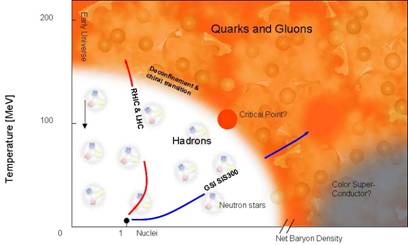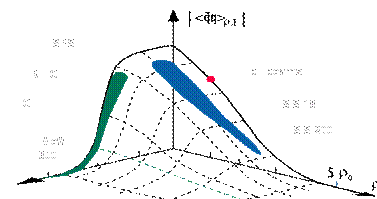Result 4
QCD and Quark Matter
The fundamental interactions of nature are described by theoretical approaches called gauge theories. Quantum Chromodynamics (QCD), the theory of strong interactions, is such a theory and it is a special one - it is a complete theory, with just a small number of parameters to be determined from experiment. It is, however, difficult to compute the manifestations of QCD in nature except in the high energy (i.e., the weak coupling) limit, where the perturbative approach is extremely successful. The structure of strongly interacting particles is not amenable to this approach. Tools for understanding this structure include experiment and computer simulations of QCD. The important questions about QCD that can be accessed with these tools may be formulated as follows:
1. What are the phases of QCD matter?
Is there a phase transition to a state of matter in which more elementary entities (called partons) than hadrons are the relevant degrees of freedom?
2. What is the wave function of the proton?
For example, how do the spin and orbital motion of the partons in the wave function of the proton account for the proton's spin?
3. What is the wave function of a heavy nucleus?
How does the growth of gluon density in hadrons reach a saturation limit in certain situations? How does the wave function of a proton in a nucleus differ from that of a free proton?
4. What is the nature of non-equilibrium processes in a fundamental theory?
How is entropy produced in processes involving quantum states of strongly interacting matter?


Gauge theories describing other fundamental interactions have similar questions and presumably the phase structure of each played its role in the very early development of the Universe. Again, the case of QCD is especially interesting. Based on the results of lattice gauge simulations, the expected phase transition from hadrons to quarks and gluons occurs at T ~ 170 MeV and can be studied in the laboratory. (This is not the case for the Electroweak phase transition, where T ~ 100 GeV, beyond the reach of any foreseeable collider.)
The experimental approach to the study of strongly interacting matter at very high temperatures involves the interaction of hadrons at very high energy. The study of the bulk properties of strongly interacting matter - implicit in most of the questions above - requires as large a volume of high energy density matter as practical. Thus, the fundamental questions about QCD and the physical states of strongly interacting matter are addressed in the laboratory by studying heavy ion collisions at relativistic energies.
In order to gain new understanding of QCD from the interaction of relativistic heavy ions, one needs directly comparable data sets with smaller system size, different energies and different experimental probes. These ancillary data sets provide "baselines" against which the largest volume, highest temperature, reactions can be compared. Thus a fundamental and systematic study of QCD requires data on A + A, A + B, p + A and p + p collisions, all at comparable nucleon-nucleon center of mass energies, preferably in the same detector systems. Hard processes, which can be accurately calculated in p + p collisions using perturbative QCD, can then serve as calibrated probes of the medium created in collisions involving nuclear beams. Addressing many of the questions above also requires data from high energy interactions of hadrons with non-hadronic probes, e.g., deep inelastic scattering (DIS) of leptons from nuclear targets ranging from protons to heavy ions. Question 2 requires the use of spin-polarized beams and/or targets at the highest energies.
Fixed target and collider experiments have contributed to the experimental attack on these questions over time. Taking beam energies of 1 GeV or greater, one has:
- fixed target heavy ion experiments (in the future at SIS200 - GSI);
- fixed target proton nucleus studies (currently at COSY and in the near term future at J-PARC);
- heavy ion collider experiments (in the future at the LHC - CERN and FAIR - GSI);
- fixed target lepton DIS experiments (at Jefferson Lab, currently at 6 GeV and in the near term future at 12 GeV);
- DIS collider experiments at DESY (HERA) – in the longer term: possibilities at BNL (eRHIC), CERN (LHeC) and JLab (ELIC);
- polarized beams/targets - in the longer term: possibilities at eRHIC and ELIC.
Recent results in this field have primarily come from RHIC at BNL and for electron-proton collisions at DESY. The four experiments at RHIC have produced new results in the first 5 years of operations. These results can be summarized briefly as follows:
At center of mass energy √sNN = 200GeV, a new state of matter has been produced, with the fo llowing properties:
- Opaqueness to strongly interacting particles (deduced from "jet quenching" measurements)
- Transparency to photons and leptons (from direct photon measurements)
- Appearance of a nearly perfect liquid of quarks and gluons, i.e., a strongly-coupled Quark-Gluon Plasma (sQGP) (from the systematics of elliptical flow)
- Consistency with the picture that it has its origin in a universal hadronic state called the Color Glass Condensate (CGC) (from particle production spectra measured at forward angles)
New questions and some experimental puzzles have resulted from these data. For example, results on source size from quantum interference measurements (called HBT), the large amount of baryon production at intermediate values of pT and the extremely rapid thermalization of the produced matter (τ ~ 0.6 fm/c) is not understood.

The restoration of the chiral symmetry of QCD as both temperature (T) and density (e) rise is expected to have dramatic effects on hadron structure in-medium.
These and many other experimental questions are open to ongoing and future investigation. These include: the flow of heavy quarks, the spectrum of thermal radiation from the produced matter, the suppression and/or enhancement of the production of entities involving charmed quarks, the evidence for CGC and the contributions to the spin of the proton of the gluon and the orbital motion of the partons. A planned luminosity upgrade at RHIC will extend and expand the reach of that facility in this direction.
In the next few years the CERN LHC heavy ion program will contribute greatly to this body of knowledge. With a nucleus-nucleus center-of-mass energy nearly 30 times larger than the one reached at RHIC, the LHC will provide the biggest step in energy in the history of heavy ion collisions and will open a new era for studying the properties of strongly interacting matter under extreme thermodynamical conditions. This new energy regime will lead to a much higher density, to a faster equilibration and to a bigger deconfined system with a longer lifetime, resulting in an enhanced role of the QGP over interactions involving hadrons. The higher temperature and close to vanishing baryonic potential of the system will make it closer to the conditions of the primordial universe. In addition, heavy ion collisions at the LHC access exceedingly small Bjorken-x values, where low momentum gluons are expected to be close to saturation and lead to a significant shadowing effect (CGC). Another exciting aspect of this new energy regime is the copious production rate of hard processes. These processes, which are produced at the early stages of the collision, are sensitive probes of the collision dynamics at both short and long timescales. They represent, at the LHC, an ideal high statistics tool for a detailed characterization of the deconfined medium.
In the next decade complementary studies of the structure of strongly interaction matter are planned for GSI's Facility for Antiproton and Ion Research (FAIR), where ion-ion collisions at lower energies can create nucleus-sized volumes of low temperature, high baryon density samples of nuclear matter.
n the longer term there are plans at BNL and Jefferson Lab to open up a new window on deep inelastic lepton-hadron experiments using electron-ion collisions. At BNL this would involve the addition of an electron ring and new detectors to the existing ion/proton rings and experiments at RHIC. At Jefferson Lab there are plans to build an electron light ion collider, building on the laboratory's expertise in superconducting RF and energy recovery technology. Both of these proposals would make available electron-ion and polarized electron-polarized proton collisions and enable new studies of the low-x structure of strongly interacting states of matter using precision (lepton) probes. Finally we note that consideration is also being given to adding an electron ring at CERN in order to study electron-nucleus collisions at extremely small values of Bjorken x and at a significantly high luminosity of 10^33cm-2s-1. All these experiments will need critical data from the 12 GeV CEBAF as an anchor that will calibrate and set the scale for interpreting high energy data.